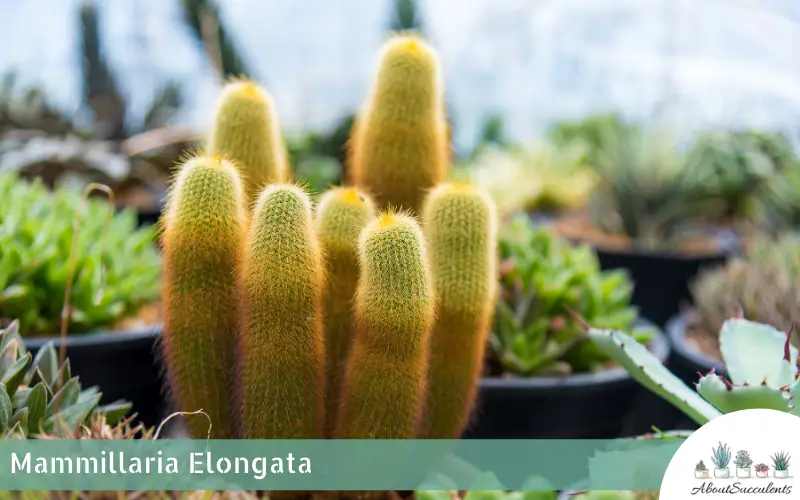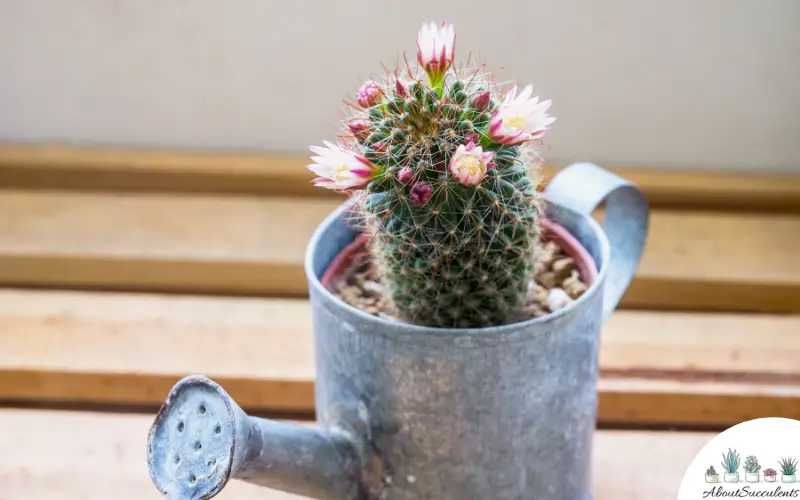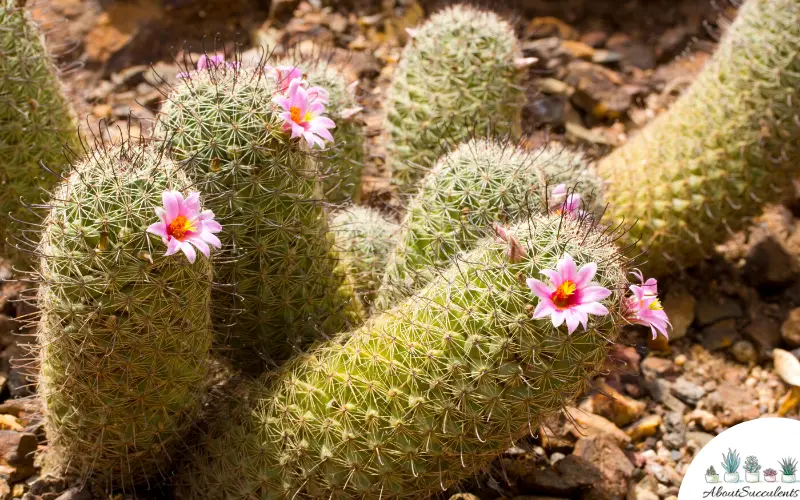
Mammillaria elongata is an alluring succulent that draws immediate attention to its clustered, elongated, and cylindrical stems which can reach a height of 6-inches (15cm) tall. Its finger-like stems can measure up to 1.2-inches (3cm) in diameter.
As a member of the Cactaceae family, Mamillaria elongata is embedded with numerous spines that vary in color from yellow to green to brown and measure 0.6-inches (1.5cm) long.
Mamillaria elongata produces flowers in the spring. The flowers vary in color from white to pink to yellow or a flushed pink with pink mid stripes.
The assembly of thick, compact, and stubby stems with the colorful spines have given the succulent highly-descriptive names such as Ladyfinger Cactus, Ladyfingers, Golden Stars, and Gold Lace Cactus.
Mamillaria elongata is native to Central Mexico.
General Information:
Also known as: Ladyfinger Cactus, Ladyfingers, Golden Stars, and Gold Lace Cactus
Plant Family: Cactaceae
Origin: Central Mexico
Height: 6-inches (15cm) tall
Exposure: Exposure to sunlight for 4 hours
Water Needs: Frequent watering during summer months; sparse to no watering in the winter or cold season.
Soil Type: Cactus soil or a potting soil mix composed of 2 parts peat moss, 1 part clean sand, and 1 part perlite.
Soil pH: Acidic (6.1 to 6.5 pH)
Maintenance Requirements: Low
Tolerance: Drought, Frost, and Heat
How to Grow and Care for Mammillaria Elongata
Mammillaria elongata is a slow-growing succulent but is easy to take care of. Similar to other members of the Cactaceae family, Ladyfinger Cactus does not need special treatment outside of frequent watering in the summer and regular exposure to sunlight.
The Mammillaria elongata is not a cold-hardy succulent. If you live in a region where the temperature drops below 20° F (-6.7° C), it is recommended to place Ladyfinger Cactus in a container that can be brought indoors.
1. Sunlight
Mammillaria elongata should be planted in an area in the garden that receives at 4 hours of sunlight per day to help it produce flowers and develop heavy spine production. If the plant gets prolonged exposure to the sun, it might get sunburn.
When grown indoors, place the succulent near a window that gets plenty of sunlight. A combination of limited sun exposure and indirect sunlight will help support plant growth.
2. Watering

Mammillaria elongate has similar watering needs as most succulents. It is best to water the plant when the soil feels dry to the touch. Ladyfinger Cactus should be frequently watered in the summer months but only sparingly in the winter.
3. Pot and Soil
Plant Mammillaria elongata in a pot that has very good drainage and one that allows excellent air circulation. The roots of Mammillaria elongata can easily be overlooked in pots that do not have good drainage.
If the plant’s roots remain submerged in a damp or moist container, it will rot and the infection will contaminate the succulent. It is highly-recommended to repot Mammillaria elongata every 2 to 3 years as the roots will run out of space and diminish air circulation.
Cactus soil is very airy and porous and will help remove excess moisture. Mix in organic ingredients such as peat and humus to further improve the quality of the soil.
Enrich the soil by adding fertilizer that is abundant in phosphorous and potassium. Make sure the fertilizer is low in nitrogen because the chemical can lead to bloating.
How to Propagate Mammillaria Elongata

Mammillaria elongata can be grown from seeds or the cuttings method. Both methods will help you grow more pieces of Ladyfinger Cactus.
1. Seeds Method
Step 1: Allow the seeds to germinate inside a glass cover where the temperature is 21 to 27° C (69.8 to 80.6° F). The germination period may take 7 to 14 days.
Step 2: As the plant develops, gradually remove the plant cover. Make sure the plants receive good ventilation.
Step 3: Do not disturb the seedlings until they have taken root.
Step 4: Once the seedlings are firmly rooted, you can remove them separately and plant the seedlings in separate pots.
2. Cuttings Method
Step 1: Cutting can only be done when the offsets which you can see at the base of the clustered specimens are 1/3 the size of the parent plant.
Step 2: Use a sharp, sterilized knife to cut the stem.
Step 3: Leave the stem in a warm and dry place to allow calluses to form.
Step 4: When the stem develops thick calluses, insert the cut part into Cactus soil mixed that has a layer of coarse grit.Step 5: Insert the cut part into the coarse grit only so that the roots can reach the nutrient-rich compost.
Frequently Asked Questions
Is Mammillaria Elongata Toxic for Cats and Dogs?
Mammillaria elongata does not appear in the list of toxic plants for cats and dogs provided by the website of the American Society for the Prevention of Cruelty to Animals (ASPCA).
Why is my Mammillaria Elongata Dying?
There are 2 possible causes for your Mammillaria elongata succulent dying: Overwatering and pest infestation.
1. Overwatering
Overwatering Ladyfinger Cactus will lead to its roots rotting and possibly infecting the entire plant with fungal infection.
Mammillaria elongata’s roots can be preserved simply by giving the plant water when the soil is completely dry and free of moisture. As a cactus, Mammillaria elongate has the ability to store water. It will not require as much watering as other succulents.
2. Pest Infestation
Mammillaria elongata is particularly attractive to many types of pests. The list of insects that may infest Ladyfinger Cactus include mealybugs and red spiders.
The best chemical remedy to remove mealybugs from Mammillaria elongata is to spray the succulent with a systemic insecticide such as imidacloprid once every few months. You can also wipe the insects with a cotton ball that is dabbed in denatured alcohol.
Red spiders can be removed by overhead watering.
Does Mammillaria Elongata Produce Flowers?
Mammillaria elongata produces flowers in the spring. The flowers are shaped like a small bell that is 10mm or 0.39-inches long. The color of the flower may vary from whitish, to pinkish, and pale yellowish.
You might see some variety of Ladyfinger Cactus with pink mid-stripes.
Last Updated on June 12, 2022 by Sofia Lara